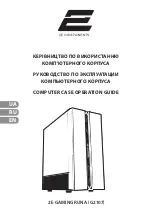
INSTALLATION
Install & use this device with care. Follow all local codes or, in the absence of
local codes, to the National Fuel Gas Code, ANSI Z 223. 1INFPA 54.
GAS LINE INSTALLATION
• Gas controls shall not be installed inside the fireplace.
• Gas controls must be properly located and shielded to prevent overheating
due to exposure to the wood fire.
• Piping which exits the fireplace will conduct heat. Adequate clearances must
be maintained from piping to combustible construction to avoid a fire hazard.
It is required that a minimum 1/2” clearance to combustibles be maintained
within 6” of where the gas line passes through any side of the fireplace. Pipe
sealant must be used on all joints.
LOG LIGHTER INSTALLATION
Log lighter should be installed on the front of the grate in such a manner to
minimize flame impingement, the amount of heat exposure and that logs placed
on the grate will not rest directly on the log lighter tube. Also, the floor clearance
should be sufficient to minimize the chance of the blockage of the burner ports by
ash accumulation.
Steps to install your log lighter
:
1. The fireplace should be free of all debris.
2. A listed Blue Flame gas valve must be installed up steam of the log lighter.
3. Run gas pipe to the log lighter. Lighter must be secured in a rigid manner.
Example: use 112” rigid pipe for gas inlet and to the log lighter (inlet 1/2”
NPT). Use pipe fittings to support the opposite plugged end of the log lighter
(1 /2” male NPT) in contact with the floor or side of the fireplace. Do not
use copper or flexible connectors inside the firebox. Locate log lighter as
indicated above and maintain proper clearances.
4. The log lighter should be located such that the burner ports are facing
inwards at 30-45 degrees, with the air shutter facing out towards the front.
Adjust the air shutter to give sharp blue flames with yellow tips.
5. The log lighter and its individual shutoff valve must be disconnected from
the gas supply piping system during any pressure testing of that system at
test pressures in excess of 1/2 psi (3.5 kPa). The log lighter must be isolated
from the gas supply piping system by closing its individual manual shutoff
valve during any pressure testing of the gas supply piping system at test
pressures equal to or less than Y, psi (3 .5 kPa).
SPECIFICATIONS
Input Rating:
20,000 Btu/hr(Model# LL(S,A)-1220NG)
26,000 Btu/hr(Model# LL(S,A)-1626NG)
40,000 Btu/hr(Model# LL(S,A)-2440NG)
51,000 Btu/hr(Model# LL(S,A)-3051 NG)
59,000 Btu/hr(Model# LL(S,A)-3659NG)
68,000 Btu/hr(Model# LL(S,A)-4068NG)
31,000 Btu/hr(2)(Model# LLT-7.531-NG)
Normal Inlet Pressure: 7” W.C. (1.74 kPa)
Maximum Inlet Pressure: 10.5” W.C. (2.61 kPa)
Minimum Inlet Pressure: 3.5” W.C. (0.87 kPa)
WARNING
Do not restrict air flow into Fireplace using the log lighter.
Make sure the chimney flue is open before attempting to operate this
device.
Make sure that glass doors are open while using the log lighter and
spark screen is closed.
Failure to observe these warnings may result in possible injury.
Owner’s Instruction Manual
Note: Propane models have LP rated mixers




















